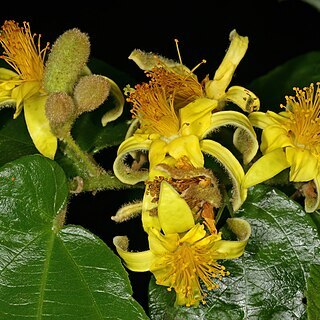Tree to 6 m tall; young shoots densely ferruginous pubescent.. Leaves oblong to obovate, 5.5–15.5 cm long, 4–10 cm wide, truncate, rounded to shortly acuminate at the apex, obliquely asymmetric at the base, ± glabrous and glossy green above, whitish tomentellous beneath; petiole 4–8 mm long.. Inflorescence a 1–3-flowered cyme, 1–2 in a leaf-axil, covered with a dense ferruginous pubescence; peduncle 5–24 mm long; pedicels 9–24 mm long.. Flowers yellow; sepals 17–24 mm long; petals 7–9 mm long, broadly ovate to ± subcircular.. Androgynophore glabrous for ± 3 mm at the base, densely pubescent and produced up to 2 mm above the node.. Stamens 11–16 mm long.. Ovary ± 3 mm long, densely hairy; style 9–10 mm long.. Fruit 2-lobed, or unlobed by abortion, the lobes 15–18 mm long, 13–16 mm wide, shortly stellate-pubescent becoming glabrescent, maturing reddish.. Fig. 4/50 (leaf, p. 11).
A shrub. It grows up to 5 m tall. It has branches from near the base which spread out widely. The young branches are covered with red hairs. The leaves are oval and the edges have teeth. They are shiny green above and whitish grey underneath. Leaves are 2.5-13 cm long and 9 cm across. The base of the leaf is lopsided. The flowers are yellow. They are honey scented. They are 2.5 cm across. The fruit have 2 lobes and are hairy and shiny. They are about 2 cm across. They are red. The fruit are edible.
Leaf-lamina 3–10 × 2·5–6 cm., elliptic to oblong-elliptic, rounded or acute at the apex, margin serrate and somewhat revolute, asymmetrically cordate at the base, glabrous and somewhat rugose above, rather shining; nerves impressed and very densely pale yellowish-tomentose below but sometimes less hairy and brownish; petiole 2–3 mm. long, or rarely up to 6 mm.
Inflorescences all axillary, on tomentose peduncles 5–10 mm. long; pedicels c. 5 mm. long, tomentose, 2–3 together; bracts up to 5 mm. long, ovate to lanceolate, glabrous inside, pubescent outside.
Petals with a subcircular lamina up to 0·7 cm. in diam. and with a basal nectariferous claw up to 2 mm. long with a short ledge above circumvillous on the inner margin pilose at the back.
Androgynophore with a very stout glabrous lower portion up to 2 mm. long, produced into a pilose upper portion up to 2 mm. long.
Shrub, 2-5 m high. Leaves discolorous, nerve interspaces tomentose, nerves with tufts of longer brownish hairs. Flowers yellow.
Ovary 2-lobed or 1-lobed by abortion, silky-villous; style up to 10 mm. long, glabrous; stigma-lobes c. 4, rounded and dilated.
Shrub 2–5 m. tall; young branches ferruginously woolly; older branches with a reddish-brown bark and pale lenticels.
Fruit reddish, deeply divided into 2 globose lobes up to 2 cm. in diam. or 1-lobed by abortion, pilose, shining.
Sepals 1·8–2·6 cm. long, linear-oblong, golden-brown tomentose on the back, glabrous and yellow within.
Flower-buds oblong-ovoid.


